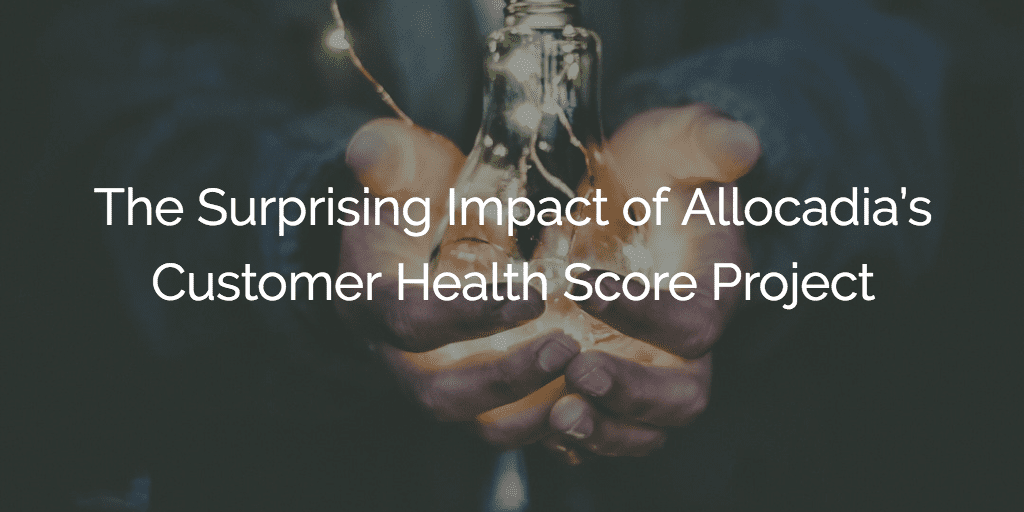Allocadia has always been a customer-driven organization. The very first customer of our Marketing Performance Management SaaS tool remains an active—and growing—user seven years after the company was founded.
Since that very first deal, we’ve grown to over 10,000 users from over 150+ organizations around the world, and that trajectory is due in part to our commitment to Customer Success.
A year ago, our CS team embarked on a critical project related to our customer health score. We knew it would be a way to better serve our customers, but it accidentally began a transformation within our organization.
This project has catapulted our Customer Success organization to new heights. Today, we have insights that allow us to be nimbler in our go-to-market strategy, align us better with Marketing and Product Management, and truly serve as a leading department within Allocadia
Here’s what happened:
Our Customer Success team was functioning at a solid pace. Customers were happy and accounts were growing, but we thought we could do more to be a true driving force for our business.
We have amazing customers who do amazing things, but didn’t have a formula or way to understand who the next great customer was (and why!) The company also has great relationships with our customers across the business, but lacked the ability to measure them, leaving us open for risk.
Enter the Allocadia health score project.
We knew we needed better insights, we knew we needed to scale, and we knew that it would be important to look beyond product adoption as a measure of health and success. We had to continue to drive best-in-class retention and eliminate surprises.
The seminal question was: How can we take advantage of what’s working to create opportunities for continued growth?
Our initial goals for this Customer Success initiative were to:
- Drive scale within our team
- Understand the state of our customer base
- Create actionable insights.
We had a working theory on what drove adoption, but needed those measures to be fully automated. We also wanted to have an objective measure of relationships with our customers that reflected the whole organization’s relationships, not just the Customer Success team.
Our team is comprised of Customer Success pros with several years’ experience in the B2B SaaS industry. When trying to measure the true health of a customer base we wanted to close the gaps of previous health scores. We knew if a customer was logging in (or not), what features they were using, and how many support cases they had logged (all common health score metrics). But there always seemed to be something missing.
This time, we got it right by addressing three new areas of customer health:
1. Getting to the Good stuff: Customer Perceived Value
Previous versions of a health score represented our definition of the health of the account, not how much value the customer perceived they were getting. As Lincoln Murphy says:
Customer Success is when your customers achieve their desired outcome through their interactions with your company.
The challenge is, how do you capture that?
Our problem was rooted in data. We connected the dots with our development and product managers, we captured more usage data in Gainsight than we ever had before, including real-time login information and feature and function-specific information. But while these measures gave us a way to know what a customer was doing with the tool, it wasn’t capturing the value they were getting. This required us to capture a new type of data—the customer’s perceived value.
We now have a measure of "value realization" within our health score. We take our customers’ measures of success and use those as a starting point. As part of our business review process we ascertain not just how well we think they’re doing, but what their desired outcomes are and their level of value.
As a byproduct of the change in our approach as a CSM team, other parts of our organization have also shifted their measures of success to a more value-based approach.
2. Using Relationships as a Driving Factor
Another gap we found in improving our health score was that we couldn’t objectively measure the strength of our relationships with our customers.
A single-threaded account is always a risk! Enter Nudge.ai.
Nudge is a platform that leverages relationship strength to help you find and keep your best customers. Nudge allows you and your team to share network information, such as email and social, providing visibility into who has the best access to decision makers and key accounts.
From experience, we knew our Support and Education teams have the broadest relationships with customers. They are speaking to far more end users than any CSM does on a regular basis. Therefore, we knew we needed not just the CSMs to be synced with Nudge, but our entire Post-Sales team.
With Nudge we have been able to identify how many relationships we need for an account to be considered "healthy" and how that differed across our segments. We’ve been able to set thresholds for both strength of relationships with our customers as well as number of active relationships.
Ensuring we are connected to the right people allowed us to reduce risk and focus on other aspects of our customers’ success.
3. Asking Impact Questions for Actionable Insights
In addition to creating a measure of health, we wanted to ensure we had the data and insights needed to establish an outcome for every interaction. Every piece of information used serves a specific purpose and drives a high value interaction.
Our goal was to prevent the "just checking in" emails.
To solve for this, we revised the information captured for every account to include:
- Most recent challenges
- Measures of success
- Important metrics and KPIs
This information could then be combined with the score to drive a contextually relevant interaction. And not just the CSM team, but our product managers, Support team and others.
It wasn’t our initial intention, but working across our Product Management and Service Delivery teams in order to capture usage, relationship and valuable milestones more effectively turned into an exercise of organizational alignment. It’s helped our Customer Success team to become a vital part of the business’s growth plans, and continue our commitment of giving confidence to every Marketing team around the world in their plans, investments, and results.

